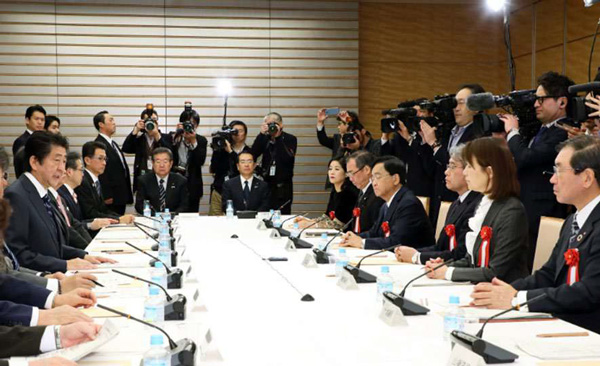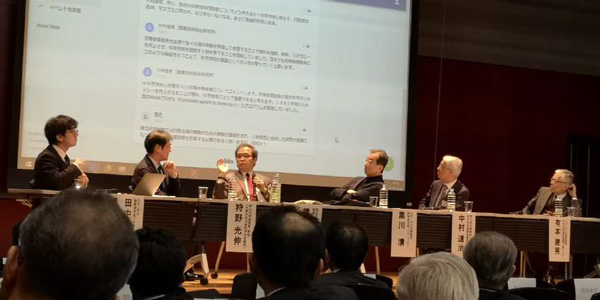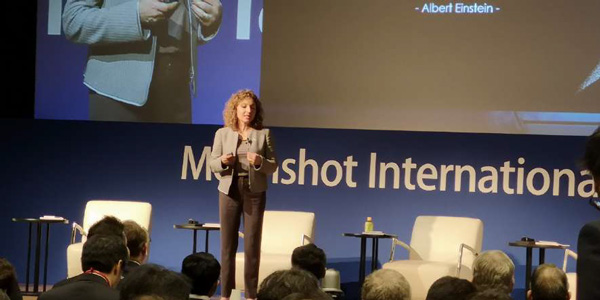News
Japan Launches Two Globally Watched R&D Projects in Quest of True Innovation Updated in March 2020
There are many Nobel Prize winners in Japan, but their works are rather short of sufficient results to produce innovation. Based on such a sense of crisis growing in Japan, the government has kicked off two new projects in an effort to restore nation-building based on science and technology: “Moonshot Research and Development (R&D) Program” and the “Program to Support Emergent Research.” The former has ambitious Moonshot goals, which are difficult to achieve but will have a great impact on Japan's future if realized. Moonshot research seeks to reform Japan's future social system. The latter aims to provide competent young researchers with an independent environment and funding to do research. Under a supplementary budget for the current fiscal year (ending March 31, 2020), approved by the Cabinet on Dec. 13, a sum of 15 billion yen was appropriated for the Moonshot R&D Program and 55 billion yen for the Program to Support Emergent Research. Selection work will begin early in 2020 to determine specific projects and researchers.
The Moonshot R&D Program is based on the country's rather lackluster national programs which fell short of sufficient international cooperation. Furthermore, aggressive R&D efforts by the United States, Europe and China based on ample funds are also prodding Japan to launch these new national programs. The scheme of the program to promote innovation was first proposed at the June 14, 2018 meeting of the Council for Science, Technology and Innovation (CSTI - chaired by Prime Minister Shinzo Abe) by expert council member Kazuhito Hashimoto (President of the National Institute for Materials Science - NIMS). The programs' basic concepts were agreed upon in December 20, 2018. The Moonshot R&D Program has great goals “to revive Japan as a nation founded on science and technology, and to regain respect and trust by the global community.”
In stressing the need for moonshot projects at the meeting, Hashimoto showcased innovation policies of other nations, including Beijing's “Made in China 2025” program as well as ambitious initiatives promoted by the United States and the European Union (EU). He also introduced other prominent R&D projects in China, like the quantum communication satellite Mozi (a.k.a. Micius), which utilizes quantum cryptography. Quantum cryptography for Mozi makes it impossible to intercept or encrypt. Prior to Japan's supplementary budget, 100 billion yen was allocated for the Moonshot R&D Program in the FY2018 budget and 2 billion yen in the FY2019 budget.

25 R&D Themes Revealed
Since March 2019, the framework of the “Moonshot R&D Program” is being determined by the “Visionary Council for the Moonshot R&D Program,” which has already met four times. The council is chaired by Yoshimitsu Kobayashi, Chairperson of Mitsubishi Chemical Holdings Corporation and “Keizai Doyukai” (Japan Association of Corporate Executives). As a starter, the council discussed the ultimate goals of the moonshot R&D program: “The purpose and urgency of the moonshot project must be understood clearly”; “The moonshot theme may be difficult to achieve but will have a great impact on Japan's future industry and society if realized”; “Values attached to the moonshot theme must be shared with many people in and outside of Japan”; and “Many people can clearly imagine the potential emerging from the moonshot theme.” Based on such opinions, the council came up with three specific R&D fields, including proposals from the general public:
a) overcoming the aging and low-birthrate society with radical innovation;
b) developing urban civilization while restoring the global environment; and
c) pioneering frontiers with science and technology.
The three fields come with goals. For overcoming the super-aging society, for instance, some goals are “to realize a society where everyone can pursue their dreams,” “to realize a society where people can enjoy life without health worries even after the age of 100,” or “to attain an industrial revolution through fully unmanned automation.”
Furthermore, the council shows more specific R&D examples such as a mission “to realize cyborg technology by 2050.” That is “to reinforce deteriorating senses and physical abilities from old age by establishing a technology to integrate robots with biological tissues.” This will allow “everyone to enhance their deteriorated abilities and overcome limitations,” according to supplementary explanations. The council has listed 25 specific examples of such R&D themes across the three fields. In early 2020, work will begin to narrow down potential research themes that may be adopted.

On Dec. 26 2019, the National Graduate Institute for Policy Studies (GRIPS) hosted an open symposium titled “What stalled Japan's science & technology and how to revive it—Re-establishing science & technology policies for Japan's future—” at its campus. Many active and former government officials and researchers involved in STI (science, technology and innovation) policy spoke as moderators and panelists. They expressed frank opinions. NIMS President Hashimoto who played a leading role in the launch of the Moonshot R&D Program, also spoke as a panelist. “We welcome criticisms and suggestions on science and technology policies, but it's important to execute any kind of solution that seems or sounds good,” he said and repeatedly stressed the need for real action. He also emphasized that unlike in the U.S., EU or China, “there are financial restrictions in Japan.” He pointed out that science and technology budget will not skyrocket simply by pushing the government to boost spending.
Great Opportunities for Young Researchers
The Program to Support Emergent Research came into shape after the Moonshot R&D Program took off to initiate concrete discussions. During the debate at the Visionary Council on the Moonshot R&D Program, one expert emphasized: “Compared to moonshot R&Ds, we need to inject more or less the same amount of funds into emergent research that are not bound by any specific target goals.” Besides the moonshot type of R&D, the expert stressed that it is necessary to implement broader arrays of research projects based on entirely new innovative initiatives, without setting specific tasks or short-term goals.
The Program to Support Emergent Research is also expected to significantly improve Japan's inadequate support system for young researchers. This has been pointed out for many years. Targets are 700 to 1,000 young researchers, mainly in their late 30s to mid-40s. The support project calls for a grant of 15 to 30 million yen per year to each researcher for up to 10 years. A funding organization may examine the ability and uniqueness of researchers and determine who will receive public financial support. Then their home universities/institutes would provide support measures to the chosen researchers. In addition to research funds, home institutions of the selected researchers will receive minimum necessary funds as “indirect expenses” to improve research environment. Through these attempts, the program hopes for unconventional emergent research to bear fruit.
Kiyoshi Kurokawa, GRIPS Senior Fellow (former President of the Science Council of Japan) who participated as panelist in this symposium reiterated his long-held assertion: “Unlike in the United States, a major problem with Japanese universities is that their associate/assistant professors are not independent.” He criticized Japan's academic system where associate/assistant professors are placed under supervision of full-fledged professors, which can hinder their independent research. We may interpret that Kurokawa subtly upheld the Program to Support Emergent Research, which was finally launched under a budget of 55 billion yen under the FY 2019 supplementary budget.
Barriers still Exist to Close Gaps with Global Rivals
From May-June 2019, Takuya Hirai, Minister of State for Science and Technology Policy (at the time), and Masahiko Shibayama, former Minister of Education, Culture, Sports, Science & Technology, visited the United States and Europe, and agreed to advance research cooperation. Furthermore, during December 17-18, JST's “Moonshot International Symposium” held in Tokyo, the United States was represented by the Director of the White House Office of Science and Technology Policy; the Director of the Office of Science, the Department of Energy; and the Director of the International Science and Engineering Department, and the National Science Foundation (NSF). Also attending were the Deputy Director-General of Research and Innovation from the European Commission and other foreign government officials. Other participants included CEOs of X Development (formerly Google X) and the XPRIZE Foundation, both American companies conducting ambitious R&D projects in the private sector. Both CEOs made keynote speeches and presentations, showing their depth of interest in Japan's new initiative.
On the other hand, some overseas participants at the meeting voiced that it is not easy for the Moonshot R&D Program to produce desired results. In a video message, CEO of X, Astro Teller, working on innovative projects like autonomous driving, described the difficulties of moonshot-type R&D:
“Huge problems around the world need some kind of break-through. In most moonshot type R&D, we usually fail. If money is the key to moonshot success, someone would have already done it. The important point is to do it in multiple teams. Starting with 100 teams, the program could narrow down to 30-40 teams by the second year, and 20 teams in the third year. It will fail if you try to get results in 3-5 years…”

Anousheh Ansari, CEO of the XPRIZE Foundation, pointed out similar concerns. The foundation is a nonprofit organization known for running competitions for the first private-sector manned sub-orbital spaceflight and for the development of a lunar lander. “First of all, select about 150 out of all papers and get them to participate in the competition. And then narrow them down to 10-15 over 3-5 years. Starting from that point on, we may raise funds and start working on prototypes,” she commented.
Opportunities for challenge must be given widely and the program must also assume many failures. Whether Japan's moonshot R&D program can adopt this approach is still too early to tell, but the endeavor may attract interest from different parts of the world.
Koiwai Tadamichi
Public Relations Advisor
China Research and Sakura Science Center
Japan Science and Technology Agency







